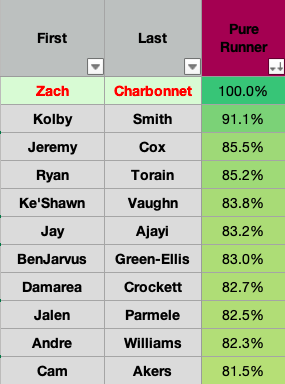This article is part of a series in which I evaluate current college running backs solely on their ability to run the ball. I previously did the same sort of analysis focused on the 2022 rookie running back class, and you can find those articles, as well as explanations of my methodology, here and here. Otherwise, feel free to skip to the player-focused analysis below.

UCLA’s Zach Charbonnet pulled a Travis Etienne this offseason. He returned to school when he almost certainly would’ve been among the first RBs selected in the 2022 NFL Draft.
As it stands, he returns to Los Angeles after posting the most productive season of his career. He eclipsed 1,000 rushing yards for the first time in 2021. However, the 24.5-percent Dominator Rating he posted last season is actually just a 54th-percentile mark among third year runners; at least among those who would go on to be drafted since 2007. With an 18.0-percent Dominator Rating that lands in the 70th-percentile, the true freshman campaign Charbonnet put together at Michigan is actually the best age-adjusted season he’s ever had.
Charbonnet did well to prove himself as a three-down back by hauling in over 20 passes for the first time in his career last season. But he’ll need more production in every area in 2022 to show that he is the dominant player his early success hinted at. He’ll also need to run the ball efficiently. Let’s see where his numbers on the ground stack up through three years.
The Metrics
To date, Zach Charbonnet has carried the ball 371 times. He averaged a 45th-percentile rate of 12.4 attempts per game. Part of that subdued volume has to do with his 19 total carries during a COVID-shortened six-game season at Michigan in 2020. His per carry average from last year would land in the 79th-percentile.
On that volume, Charbonnet has averaged 0.22 yards per carry greater than teammates who collective averaged a 2.65-star rating as high school recruits. That means he has posted a 37th-percentile YPC+ mark relative to teammates with 26th-percentile pedigree. Not great. Even less impressive is his consistency in ripping off 10-yard runs relative to theirs. His career mark in Chunk Rate+ is -1.35-percent, landing in the 26th-percentile.
All that has been done while Charbonnet has seen box counts that are 0.06 defenders lighter, on average, than those his teammates have faced, a 34th-percentile discrepancy. So he has been barely more efficient than his subpar backfield mates have been. All while having an easier rode to yardage than they have had.
Accounting for those box counts means that the average carry for Charbonnet has been worth 110.7-percent the output of the average non-Charbonnet carry at Michigan and UCLA during his career. That Box-Adjusted Efficiency Rating is positive, but it’s just a 39th-percentile mark.
From a consistency standpoint, Charbonnet has been straight up bad. He has never posted a season in which he has succeeded on his runs more often that his running back teammates have. And his career mark in Relative Success Rate is -1.2-percent. That is a 32nd-percentile number.
Charbonnet has also not been particularly effective in the open field. His 30.2-percent Breakaway Conversion Rate is in the 47th-percentile.
Rushing Efficiency Score and Comps
My process combines percentile scores in the above metrics (in addition to adjustments for overall team quality and strength of opponent) to generate composite scores that quantify a player’s overall rushing efficiency profile. In a composite that uses BAE Rating and RSR, Zach Charbonnet earns a 33.8 out of 100. In a composite that uses the non-box count-related metrics, he earns a 29.8. He doesn’t have a single season on his resume with impressive team-relative efficiency numbers.
Using the same metrics that go into those rushing efficiency composites (in addition to physical measurables), I am also able to generate similarity scores between current and past prospects as a way of formulating comps. Using historical college height and weight data for eventual NFL running backs , I project Charbonnet to be 6-0, 2/8-inches and 224-pounds at his eventual Combine weigh-in. If he runs a 4.50 40-yard dash at that size, the following players will be his ten closest comps from a “pure runner” perspective:

Cam Akers is promising and Jay Ajayi once had a nice stretch of games. But it’s tough to confidently say that any of the guys on this list are legitimately good NFL players. It’s simply not often that players who run the ball as ineffectively as Charbonnet has in college go on to be quality pro rushers.
Last Word
Zach Charbonnet is a big dude with four-star pedigree and years of hype fueling his value in devy leagues. But he’s never been that good of a runner in college. You should exercise a lot of caution when considering rostering him. Name brand value aside, he’s probably just bad.


